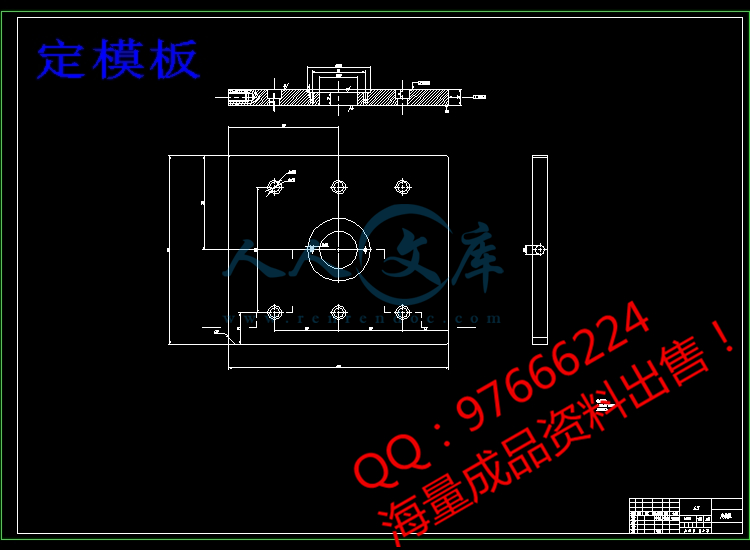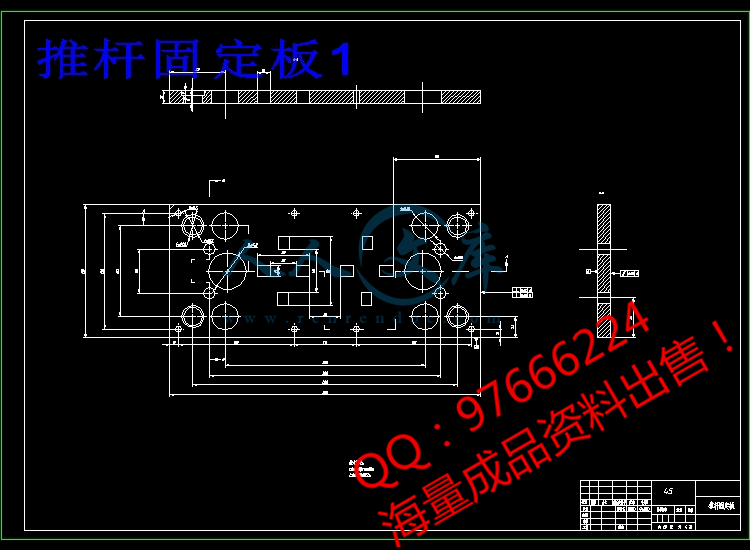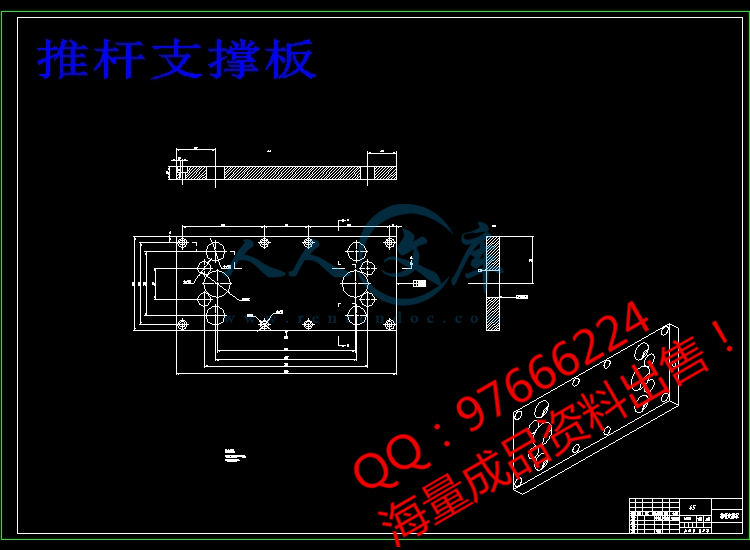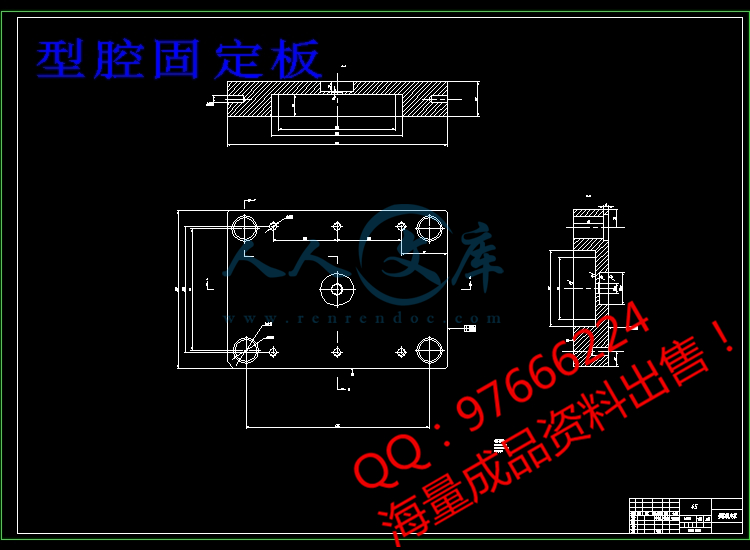肥皂盒上盖注塑模具设计【26张图纸】【优秀】【word+CAD全套设计】
收藏
资源目录

压缩包内文档预览:
编号:443832
类型:共享资源
大小:5.51MB
格式:ZIP
上传时间:2015-06-26
上传人:小***
认证信息
个人认证
林**(实名认证)
福建
IP属地:福建
50
积分
- 关 键 词:
-
x0029
肥皂盒
注塑
模具设计
- 资源描述:
-
摘 要
从分析塑料零件注塑模具设计的全过程,并从其加工工艺性出发,选取了较为合理的设计方案,经工艺计算并初步确定模具结构方案,最后进行模具各个部分零件的设计。由于本产品结构比较复杂,模具结构及制造工艺相对较为复杂,生产批量为大批量,精度为IT14,则成本会比较高。且模具采用的是一模两腔的设计,所以增加了结构的复杂性,通过对抽芯机构的计算和设计,同时把握模具相关运动部件的设计,其中包括定位零件和成型零件尺寸的计算和校核。该模具采用了一次分型,使制件的主流道凝料和分流道凝料从模具的成型板中脱出,最后利用推杆推出作用,使制件脱离型芯,达到制件的生产。同时,本模具的亮点和难点在于有两个带角度的内侧抽芯和其型芯型腔的加工复杂性上,但通过比较合理的斜顶装置可以很完善的达到内抽的效果,并且该机构制造相对简单,可降低模具成本。在一些零件的选用上也是尽量选取标准件以降低模具造价,型芯和型腔都采用镶拼式的结构,同时运用直通式冷却水道,降低加工难度和成本。最后分析模具装配和型腔的加工工艺性。
关键词:注塑模;分型面;抽芯主要符号表
k安全系数E材料弹性模量
Smax塑料的最大收缩率q熔融塑料在模腔内的压力
Smin塑料的最小收缩率V塑塑件体积
P0注射压力V注注射机理论注射量
P公公称注射压力F锁锁模力
Δs塑件公差δs塑件收缩引起的塑件尺寸误差
T注射机的额定锁模力LS塑件尺寸
L凹型腔尺寸L凸型芯尺寸
H塑塑件內形深度基本尺寸S注射机最大行程
d塑件外径基本尺寸H 模具闭合尺寸
D塑件內形基本尺寸Hmin模具最小尺寸
h凸模/型芯高度尺寸Hmax模具最大尺寸
δ模具制造公差α倾斜角
A塑件包紧型芯的侧面积p单位面积塑件对型芯的正力
F塑件的投影面积n个数
P型腔压力f摩擦系数
φ长度系数Q总脱模力
目 录
摘 要I
AbstractII
1 前言1
1.1 概述1
1.2 国内外模具的相关情况2
1.3研究本课题的意义3
2 塑料ABS分析6
2.1基本特性6
2.2成型特性6
2.3综合性能6
2.4ABS的注射工艺参数7
3 塑料模的总体设计8
3.1塑件的形状尺寸8
3.2型腔数目的决定及排布8
3.3注射机的选择9
3.4分型面确定9
3.5模架的选择10
3.5.1型腔壁厚的计算10
3.5.2凹模型腔底部高度11
3.5.3模架的选择11
4 成型尺寸及浇注系统设计12
4.1型腔的内径计算12
4.2型腔的深度尺寸计算12
4.3型芯的外径计算12
4.4型芯的高度计算13
4.5浇注系统的初步计算13
5 导柱导向机构的设计15
5.1导柱导向机构的作用15
5.2导柱导套的选择15
6 脱出机构设计16
6.1推出机构的组成16
6.2设计原则16
6.3脱模力的计算16
6.4推板脱出机构计算17
6.5脱模机构设计18
6.5.1简单脱模18
6.5.2侧向抽芯机构设计19
7 排气温控系统设计22
7.1温控系统设计22
7.2注射模冷却系统设计原则22
7.3冷却系统的结构设计23
7.4 冷却水孔直径计算24
7.5求冷却水在水孔里的流速24
8 注射机与模具型腔型芯强度校核25
8.1注射机的校核25
8.2型腔型芯的强度校核25
9 模具的装配、试模与维修26
9.1模具的装配26
9.2模具装配的主要内容26
9.2.1型芯装配26
9.2.2型腔的装配加工26
9.2.3导柱、导套的装配26
9.2.4顶杆装配加工26
9.2.5浇口套的装配加工26
9.3装配顺序27
9.4试模27
9.5模具的维修27
10 模具装配图28
11 模具可行性分析29
11.1本模具的特点29
11.2市场效益及经济效益分析29
参考文献30
总结31
致 谢32

















- 内容简介:
-
毕业设计(论文)外文资料翻译系 别:专 业:班 级:姓 名:学 号: 2015年3月 塑料注塑模具并行设计Assist.Prof.Dr. A. YAYLA /Prof.Dr. Pa a YAYLA摘要 塑料制品制造业近年迅速成长。其中最受欢迎的制作过程是注塑塑料零件。注塑模具的设计对产品质量和效率的产品加工非常重要。模具公司想保持竞争优势,就必须缩短模具设计和制造的周期。 模具是工业的一个重要支持行业,在产品开发过程中作为一个重要产品设计师和制造商之间的联系。产品开发经历了从传统的串行开发设计制造到有组织的并行设计和制造过程中,被认为是在非常早期的阶段的设计。并行工程的概念(CE)不再是新的,但它仍然是适用于当今的相关环境。团队合作精神、管理参与、总体设计过程和整合IT工具仍然是并行工程的本质。CE过程的应用设计的注射过程包括同时考虑塑件设计、模具设计和注塑成型机的选择、生产调度和成本中尽快设计阶段。 介绍了注射模具的基本结构设计。在该系统的基础上,模具设计公司分析注塑模具设计过程。该注射模设计系统包括模具设计过程及模具知识管理。最后的原则概述了塑料注射模并行工程过程并对其原理应用到设计。关键词:塑料注射模设计、并行工程、计算机辅助工程、成型条件、塑料注塑、流动模拟1、简介 注塑模具总是昂贵的,不幸的是没有模具就不可能生产模具制品。每一个模具制造商都有他/她自己的方法来设计模具,有许多不同的设计与建造模具。当然最关键的参数之一,要考虑到模具设计阶段是大量的计算、注射的方法,浇注的的方法、研究注射成型机容量和特点。模具的成本、模具的质量和制件质量是分不开的 在针对今天的计算机辅助充型模拟软件包能准确地预测任何部分充填模式环境中。这允许快速模拟实习,帮助找到模具的最佳位置。工程师可以在电脑上执行成型试验前完成零件设计。工程师可以预测过程系统设计和加工窗口,并能获得信息累积所带来的影响,如部分过程变量影响性能、成本、外观等。2、注射成型法 注塑成型是最有效的方法之一,将塑料最好的一面呈现。这是普遍用于制造复杂的制件,优点是简单、经济、准确与少浪费。塑料零件的批量生产主要采用模具。产品设计制造过程包括模具的结构必须经过外观评价和结构优化。当设计师创造注射模具组件时,他们面临一个巨大的多种选择,并行工程需要一个工程师考虑制产品在发展阶段时的过程设计。一个好的产品设计为了满足市场其制造过程是不可能太贵的。CAD/CAM整合了过程仿真、快速成形制造能减少风险,进一步提高产品开发的有效性。3、注塑模具设计重要的计算机辅助 注射模具设计任务是相当复杂的。计算机辅助工程(CAE)分析工具提供了巨大的优势让设计工程师考虑几乎所有模具、注塑参数没有真正利用的地方。在可能性的设计、理念设计师,给工程师们机会去消除潜在的问题,开始真正的生产。此外,在虚拟环境中,设计师可以快速而方便地评估特定的成型参数敏感性的质量和生产最终产品。所有这些分析工具使所有模具设计将在一天甚至数小时完成,而不需要几周或几个月来做真正的实验反复试验。CAE用于早期设计的部分,模具和注塑模具参数、节约成本是实质功能不仅是最好的部分,而且还能节省和缩短开发产品推向市场的时间。 在所有方面的成型过程中需要满足塑料部分设置的公差,包括零件的尺寸和形状,树脂的化学结构、填料使用,模具型腔布置、浇注、模具冷却并释放机制使用。面对这复杂性,设计师经常使用电脑设计工具,如有限元分析(FEA)和充型分析(MFA),减少开发时间和成本。有限元分析确定部分结构的应变、应力和挠度,在那里这些参数可以很好地被定义。冲型分析位置和大小进行优化树脂流动。它还定义了焊缝的位置、面积过大的压力,以及如何影响墙壁和肋厚度流动。其它有限元分析设计工具包括模具冷却温度分布,分析周期时间和收缩为空间控制和预测冻结应力、翘曲变形等情况。 采用CAE分析部分压缩模如图1所示。分析周期始于创造一个CAD模型和有限元网格的模具腔。在注入条件规定,充型、纤维取向、固化和热历史、收缩和翘曲变形等情况进行仿真。该材料的性能计算模型模拟可用于结构的行为的一部分。如果需要部分设计浇口位置及加工条件可以在电脑上修改,直到一个可接受的零件的表达式。摘要分析了一个优化完成部分可采用降低weldline(亦即也knitline),优化力量、控制温度和固化、最小收缩和翘曲变形等情况。 模具加工的前身是手工制作,如检查每一剪机床维修工。自动化的增长和普遍使用的电脑数值控制或CNC加工中心使这过程变得更加简便。设计的时间也被大大降低通过使用特殊的软件能够产生刀具路径直接从CAD数据文件提取。主轴速度高达100000每分钟转速提一步提出了高速加工。切削材料已经证明了惊人的表现而不使用任何的剪切/冷却液,什么都没有。作为一个结果,加工过程复杂的型心和型腔已经加快了。 这是一个好消息,产生一个模具所花费的时间不断的被减少。坏消息是,另一方面,甚至所有这些进步、设计和制造的模具仍然要花很长时间,是非常昂贵的。图1的注射模CAE分析部分 许多公司的经理人现在体会部署新产品推向市场迅速发展是多么的重要。企业的繁荣关键在于新产品。他们推动企业的收入、市场份额、底线和股票价格。一个公司能够发明优质的产品和合理的价格领先其竞争不仅实现了100%的打败市场竞争对手的产品,但之前到达也倾向于保持主导地位甚至几年之后终于宣布竞争产品(史密斯,1991)。对大多数产品来说,这两个优势是戏剧性的。现在产品快速发展的一个关键方面的竞争成功。图2显示,只有3 - 7%的产品结构与一般的工业或电子公司是小于5岁。公司在第一四分位,这个数字增加到15 - 25%。一流的公司,它是60 - 80%(汤普森,1996)。最好的公司在不断开发新产品。在惠普,超过80%的利润结果从产品小于2岁!(Neel,1997)图2重要的新产品(雅克布,2000) 以先进的计算机技术和人工智能,努力已经被指向降低成本和交货时间在设计和制造注塑模具。注塑模具设计主要感兴趣的地区,因为它是一个复杂的过程涉及到很多表面设计等各零件的模具,每个都需要专家的知识和经验。李et.艾尔。(1997)提出了一种系统的方法关于注塑模具设计的知识库和并行工程环境。4并行工程在模具设计中 并行工程(CE)是一个系统性的方法来集成产品开发过程。它代表了团队合作的价值观、信任和分享,以这样的方式,决策是通过协商一致,包括视角并联,从一开始就产品的整个生命周期(埃文斯,1998)。从本质上讲,CE提供合作、合作、集体和同步工程的工作环境。一个并行工程的方法是基于五个关键要素:1、过程2、多学科小组3、综合设计模型4、设施5、软件基础设施图3的方法对塑料注射模设计,工程b)串并行工程 在塑料模具制造业、CE是很重要的,由于高成本加工和长交货期。通常,CE利用制造原型模具在设计之初相位分析和调整设计。生产制造模具是作为最后一步。制造过程,包括模具的结构必须经过外观评价和结构优化的产品设计。CE要求工程师考虑生产过程中产品设计的发展阶段。一个好的设计产品是满足市场如果其制造过程是不可能的。CAD/CAM整合过程模拟、快速成形制造能减少风险,从效率和进一步提高产品开发的有效性。 多年来,设计师已经被限制在他们可以产出通常必须设计制造(DFM)那就是,调整他们的设计意图,使元件(或总成)生产使用一个特定的进程或程序。此外,如果一个模具用于产生一个项目,而因此自动设计对固有限制在一开始就相处得很好。以注塑为例,以处理一个组件成功,即使在最小程度上,下面的设计元素需要考虑的内容:1、.几何 .拔模斜度 .非内角形状 .近恒壁厚 .复杂性 .分裂线位置 .表面抛光材料选择元件的合理化(减少组件)成本 在注塑、生产的模具生产注射模具元件通常是最长的部分产品开发过程。当利用快速造型、CAD需要长时间,因此成为瓶颈。 废水处理工程的工艺设计和注塑塑料涉及相当复杂且耗时的活动,包括零件设计、模具设计、注塑成型机的选择、生产排程、工装和成本估算。所有这些活动是传统上由部分设计和模具制作人员按注射模顺序的方式完成后塑料部件的设计。很明显的,这些序列阶段可能会导致长的产品开发时间。但随着社会的过程中实施并行工程所有参数影响产品设计、模具设计、机械的选择、生产排程、模具和加工成本被认为是尽早塑料部件的设计。 使用时有效,CAE方法节省了部分设计及制造巨大的成本和时间。这些工具几乎让工程师测试部分处理它在其正常使用寿命表现怎样。材料供应商,设计师和制造商应该运用这些工具同时在设计之初阶段利用CAE增加塑料成本效益。CAE技术使人们有可能取代传统,顺序决策程序和并行设计过程,其中各方之间是如何产生互动和分享信息,图3塑料注塑、CAE及相关设计数据提供一个综合的环境,为便于并行工程的设计、制造和模具部分,以及材料的选择和模拟优化工艺控制参数。 定性费用有关的部分比较设计上的变化被显示在图4,显示出一个事实,那就是当设计已经改好了在早期阶段在计算机屏幕上时,与成本有关的顺序的10.000倍,如果低于部分生产。这些改变可能发生在塑料部件模具的改变,如浇口位置、厚度变化、生产延迟,质量成本、机械安装时间,或是设计变更在塑料部件。图4的成本在部分改变设计产品开发周期(张志刚,2001年版) 在早期设计阶段,设计师设计模具部分必须完成零件设计基于各自的经验相似的部分。但是随着部分变得更为复杂,它变得相当困难的加工性能预测及部分不使用计算机辅助工具。因此,即使是相对复杂的部分,使用计算机辅助工具,防止变化和昂贵的设计过程中出现的问题,可以注射后。为成功实施并行工程,必须有归属感从人人参与。5个案研究 图5显示初始CAD(计算机辅助设计)塑料部分用于喷灌消防栓的腿。一个基本特征,部分的部分保持平注射后,在注射操作原因变形问题。 另一个重要特点的塑料部件必须是一种高效的抗弯刚度。一批料中加入了不同取向的部分如图5 b。这些应设计成一种方式,它有贡献的重量最小部分的,而且是可行的。 在模具的设计流程,分析了塑料部分进行了模具仿真分析软件让选拔的最佳浇口位置图6。这个数字表明最好的点浇口位置的中间馈线的中心部分。作为失真和陶瓷注射后的部分,至关重要的是,从功能的角度,它必须被保持在最低水平,同样也使用软件里面分析。图5 b显示结果暗示了事实后残留在陶瓷注射预定义的尺寸公差。6总结 在塑料注塑、CAD模型所得的塑料部分商业的3 D程序可用于部分性能和注塑工艺分析。借助于CEA技术和并行工程方法的使用,不仅注塑模具的设计和制造可以在很短的一段时间完成,而且它可能在开始时的模具设计把出现的所有潜在的问题从部分设计、模具设计和工艺参数消除。这两个工具帮助设计师和模具制造商生产良好的产品,更好的交付和更快的模具用较少的时间和金钱。【原文一】CONCURRENT DESIGN OF PLASTICS INJECTION MOULDS Assist.Prof.Dr. A. YAYLA /Prof.Dr. Pa a YAYLAAbstract The plastic product manufacturing industry has been growing rapidly in recent years. One of the most popular processes for making plastic parts is injection moulding. The design of injection mould is critically important to product quality and efficient product processing. Mould-making companies, who wish to maintain the competitive edge, desire to shorten both design and manufacturing leading times of the by applying a systematic mould design process. The mould industry is an important support industry during the product development process, serving as an important link between the product designer and manufacturer. Product development has changed from the traditional serial process of design, followed by manufacture, to a more organized concurrent process where design and manufacture are considered at a very early stage of design. The concept of concurrent engineering (CE) is no longer new and yet it is still applicable and relevant in todays manuf acturing environment. Team working spirit, management involvement, total design process and integration of IT tools are still the essence of CE. The application of The CE process to the design of an injection process involves the simultaneous consideration of plastic part design, mould design and injection moulding machine selection, production scheduling and cost as early as possible in the design stage. This paper presents the basic structure of an injection mould design. The basis of this system arises from an analysis of the injection mould design process for mould design companies. This injection mould design system covers both the mould design process and mould knowledge management. Finally the principle of concurrent engineering process is outlined and then its principle is applied to the design of a plastic injection mould. Keywords :Plastic injection mould design, Concurrent engineering, Computer aided engineering, Moulding conditions, Plastic injection moulding, Flow simulation 1. Introduction Injection moulds are always expensive to make, unfortunately without a mould it can not be possible ho have a moulded product. Every mould maker has his/her own approach to design a mould and there are many different ways of designing and building a mould. Surely one of the most critical parameters to be considered in the design stage of the mould is the number of cavities, methods of injection, types of runners, methods of gating, methods of ejection, capacity and features of the injection moulding machines. Mould cost, mould quality and cost of mould product are inseparableIn todays completive environment, computer aided mould filling simulation packages can accurately predict the fill patterns of any part. This allows for quick simulations of gate placements and helps finding the optimal location. Engineers can perform moulding trials on the computer before the part design is completed. Process engineers can systematically predict a design and process window, and can obtain information about the cumulative effect of the process variables that influence part performance, cost, and appearance. 2. Injection Moulding Injection moulding is one of the most effective ways to bring out the best in plastics. It is universally used to make complex, finished parts, often in a single step, economically, precisely and with little waste. Mass production of plastic parts mostly utilizes moulds. The manufacturing process and involving moulds must be designed after passing through the appearance evaluation and the structure optimization of the product design. Designers face a huge number of options when they create injection-moulded components. Concurrent engineering requires an engineer to consider the manufacturing process of the designed product in the development phase. A good design of the product is unable to go to the market if its manufacturing process is impossible or too expensive. Integration of process simulation, rapid prototyping and manufacturing can reduce the risk associated with moving from CAD to CAM and further enhance the validity of the product development. 3. Importance of Computer Aided Injection Mould Design The injection moulding design task can be highly complex. Computer Aided Engineering (CAE) analysis tools provide enormous advantages of enabling design engineers to consider virtually and part, mould and injection parameters without the real use of any manufacturing and time. The possibility of trying alternative designs or concepts on the computer screen gives the engineers the opportunity to eliminate potential problems before beginning the real production. Moreover, in virtual environment, designers can quickly and easily asses the sensitivity of specific moulding parameters on the quality and manufacturability of the final product. All theseCAE tools enable all these analysis to be completed in a meter of days or even hours, rather than weeks or months needed for the real experimental trial and error cycles. As CAE is used in the early design of part, mould and moulding parameters, the cost savings are substantial not only because of best functioning part and time savings but also the shortens the time needed to launch the product to the market. The need to meet set tolerances of plastic part ties in to all aspects of the moulding process, including part size and shape, resin chemical structure, the fillers used, mould cavity layout, gating, mould cooling and the release mechanisms used. Given this complexity, designers often use computer design tools, such as finite element analysis (FEA) and mould filling analysis (MFA), to reduce development time and cost. FEA determines strain, stress and deflection in a part by dividing the structure into small elements where these parameters can be well defined. MFA evaluates gate position and size to optimize resin flow. It also defines placement of weld lines, areas of excessive stress, and how wall and rib thickness affect flow. Other finite element design tools include mould cooling analysis for temperature distribution, and cycle time and shrinkage analysis for dimensional control and prediction of frozen stress and warpage. The CAE analysis of compression moulded parts is shown in Figure 1. The analysis cycle starts with the creation of a CAD model and a finite element mesh of the mould cavity. After the injection conditions are specified, mould filling, fiber orientation, curing and thermal history, shrinkage and warpage can be simulated. The material properties calculated by the simulation can be used to model the structural behaviour of the part. If required, part design, gate location and processing conditions can be modified in the computer until an acceptable part is obtained. After the analysis is finished an optimized part can be produced with reduced weldline (known also knitline), optimized strength, controlled temperatures and curing, minimized shrinkage and warpage. Machining of the moulds was formerly done manually, with a toolmaker checking each cut. This process became more automated with the growth and widespread use of computer numerically controlled or CNC machining centres. Setup time has also been significantly reduced through the use of special software capable of generating cutter paths directly from a CAD data file. Spindle speeds as high as 100,000 rpm provide further advances in high speed machining. Cutting materials have demonstrated phenomenal performance without the use of any cutting/coolant fluid whatsoever. As a result, the process of machining complex cores and cavities has been accelerated. It is good news that the time it takes to generate a mould is constantly being reduced. The bad news, on the other hand, is that even with all these advances, designing and manufacturing of the mould can still take a long time and can be extremely expensive. Figure 1 CAE analysis of injection moulded parts Many company executives now realize how vital it is to deploy new products to market rapidly. New products are the key to corporate prosperity. They drive corporate revenues, market shares, bottom lines and share prices. A company able to launch good quality products with reasonable prices ahead of their competition not only realizes 100% of the market before rival products arrive but also tends to maintain a dominant position for a few years even after competitive products have finally been announced (Smith, 1991). For most products, these two advantages are dramatic. Rapid product development is now a key aspect of competitive success. Figure 2 shows that only 37% of the product mix from the average industrial or electronics company is less than 5 years old. For companies in the top quartile, the number increases to 1525%. For world-class firms, it is 6080% (Thompson, 1996). The best companies continuously develop new products. At Hewlett-Packard, over 80% of the profits result from products less than 2 years old! (Neel, 1997) Figure 2. Importance of new product (Jacobs, 2000) With the advances in computer technology and artificial intelligence, efforts have been directed to reduce the cost and lead time in the design and manufacture of an injection mould. Injection mould design has been the main area of interest since it is a complex process involving several sub-designs related to various components of the mould, each requiring expert knowledge and experience. Lee et. al. (1997) proposed a systematic methodology and knowledge base for injection mould design in a concurrent engineering environment. 4. Concurrent Engineering in Mould Design Concurrent Engineering (CE) is a systematic approach to integrated product development process. It represents team values of co-operation, trust and sharing in such a manner that decision making is by consensus, involving all per spectives in parallel, from the very beginning of the product life-cycle (Evans, 1998). Essentially, CE provides a collaborative, co-operative, collective and simultaneous engineering working environment. A concurrent engineering approach is based on five key elements: 1. process 2. multidisciplinary team 3. integrated design model 4. facility 5. software infrastructure Figure 3 Methodologies in plastic injection mould design, a) Serial engineering b) Concurrent engineering In the plastics and mould industry, CE is very important due to the high cost tooling and long lead times. Typically, CE is utilized by manufacturing prototype tooling early in the design phase to analyze and adjust the design. Production tooling is manufactured as the final step. The manufacturing process and involving moulds must be designed after passing through the appearance evaluation and the structure optimization of the product design. CE requires an engineer to consider the manufacturing process of the designed product in the development phase. A good design of the product is unable to go to the market if its manufacturing process is impossible. Integration of process simulation and rapid prototyping and manufacturing can reduce the risk associated with moving from CAD to CAM and further enhance the validity of the product development.For years, designers have been restricted in what they can produce as they generally have to design for manufacture (DFM) that is, adjust their design intent to enable the component (or assembly) to be manufactured using a particular process or processes. In addition, if a mould is used to produce an item, there are therefore automatically inherent restrictions to the design imposed at the very beginning. Taking injection moulding as an example, in order to process a component successfully, at a minimum, the following design elements need to be taken into account: 1. . geometry; . draft angles, . Non re-entrants shapes, . near constant wall thickness, . complexity, . split line location, and . surface finish, 2. material choice; 3. rationalisation of components (reducing assemblies); 4. cost. In injection moulding, the manufacture of the mould to produce the injection-moulded components is usually the longest part of the product development process. When utilising rapid modelling, the CAD takes the longer time and therefore becomes the bottleneck. The process design and injection moulding of plastics involves rather complicated and time consuming activities including part design, mould design, injection moulding machine selection, production scheduling, tooling and cost estimation. Traditionally all these activities are done by part designers and mould making personnel in a sequential manner after completing injection moulded plastic part design. Obviously these sequential stages could lead to long product development time. However with the implementation of concurrent engineering process in the all parameters effecting product design, mould design, machine selection, production scheduling, tooling and processing cost are considered as early as possible in the design of the plastic part. When used effectively, CAE methods provide enormous cost and time savings for the part design and manufacturing. These tools allow engineers to virtually test how the part will be processed and how it performs during its normal operating life. The material supplier, designer, moulder and manufacturer should apply these tools concurrently early in the design stage of the plastic parts in order to exploit the cost benefit of CAE. CAE makes it possible to replace traditional, sequential decision-making procedures with a concurrent design process, in which all parties can interact and share information, Figure 3. For plastic injection moulding, CAE and related design data provide an integrated environment that facilitates concurrent engineering for the design and manufacture of the part and mould, as well as material selection and simulation of optimal process control parameters.Qualitative expense comparison associated with the part design changes is shown in Figure 4 , showing the fact that when design changes are done at an early stages on the computer screen, the cost associated with is an order of 10.000 times lower than that if the part is in production. These modifications in plastic parts could arise fr om mould modifications, such as gate location, thickness changes, production delays, quality costs, machine setup times, or design change in plastic parts. Figure 4 Cost of design changes during part product development cycle (Rios et.al, 2001) At the early design stage, part designers and moulders have to finalise part design based on their experiences with similar parts. However as the parts become more complex, it gets rather difficult to predict processing and part performance without the use of CAE tools. Thus for even relatively complex parts, the use of CAE tools to prevent the late and expensive design changesand problems that can arise during and after injection. For the successful implementation of concurrent engineering, there must be buy-in from everyone involved. 5. Case Study Figure 5 shows the initial CAD design of plastics part used for the sprinkler irrigation hydrant leg. One of the essential features of the part is that the part has to remain flat after injection; any warping during the injection causes operating problems. Another important feature the plastic part has to have is a high bending stiffness. A number of feeders in different orientation were added to the part as shown in Figure 5b. These feeders should be designed in a way that it has to contribute the weight of the part as minimum as possible. Before the design of the mould, the flow analysis of the plastic part was carried out with Moldflow software to ena
- 温馨提示:
1: 本站所有资源如无特殊说明,都需要本地电脑安装OFFICE2007和PDF阅读器。图纸软件为CAD,CAXA,PROE,UG,SolidWorks等.压缩文件请下载最新的WinRAR软件解压。
2: 本站的文档不包含任何第三方提供的附件图纸等,如果需要附件,请联系上传者。文件的所有权益归上传用户所有。
3.本站RAR压缩包中若带图纸,网页内容里面会有图纸预览,若没有图纸预览就没有图纸。
4. 未经权益所有人同意不得将文件中的内容挪作商业或盈利用途。
5. 人人文库网仅提供信息存储空间,仅对用户上传内容的表现方式做保护处理,对用户上传分享的文档内容本身不做任何修改或编辑,并不能对任何下载内容负责。
6. 下载文件中如有侵权或不适当内容,请与我们联系,我们立即纠正。
7. 本站不保证下载资源的准确性、安全性和完整性, 同时也不承担用户因使用这些下载资源对自己和他人造成任何形式的伤害或损失。

人人文库网所有资源均是用户自行上传分享,仅供网友学习交流,未经上传用户书面授权,请勿作他用。
 川公网安备: 51019002004831号
川公网安备: 51019002004831号